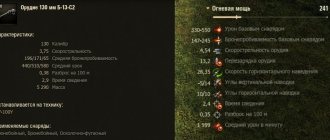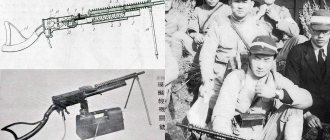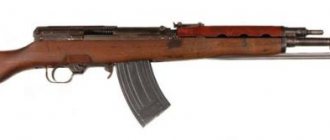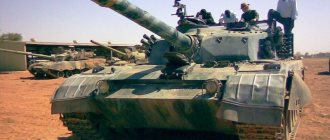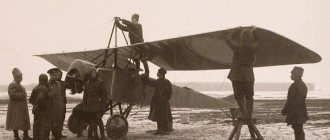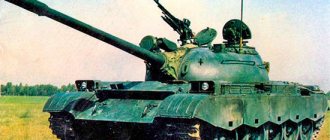Cons of Type 64
✔ The armor of the tank, frankly speaking, is not enough, I don’t remember a case where someone managed not to penetrate me, the damage went into the chassis, but as you understand, this is completely different
✔ The turret is from the M18 Hellcat tank destroyer and it rotates about the same, okay, okay, a little faster
✔ Lack of preferential conditions, so prepare in advance to play in battles with tanks up to level VIII, hence the following disadvantage
✔ The tank is sometimes demanding on BP shells, which certainly negatively affects silver farming
✔ Symbolic ammunition, if you are actively shooting shells until the end of the battle there may simply not be enough
Type 64 is a Japanese automatic rifle. Device
Although Kijiro Nambu developed an automatic rifle before World War I, the Japanese armed forces used repeating rifles even before 1945. In the thirties, and after unsuccessfully testing their own machine guns, they tried to copy the standard weapon of the American military, the M1 Garand rifle. However, the small number of experimental versions of weapons used in the Japanese navy did not play a big role; mass production was out of the question in the last two years of the Second World War.
Type 64 profitability (farm)
When playing on this Type 64, the main silver will come to you from the light. Moreover, passive light in this regard demonstrates the highest performance; another thing is that not all cards allow you to realize the potential inherent in the tank. Below is a collection of post-battle screenshots with different achievements, but without the use of AP shells, by the way, in 80% of battles they were not required
Automatic rifle Type 64 - video
In 1964, the Type 64 automatic rifle, manufactured by Howa Machinery Ltd., Shinkawaho, was put into service with the Japanese army. This modern design weapon was developed under the leadership of General K. Iwashita. It uses the energy of powder gases. The Type 64 rifle has a block action and a three-stage gas pressure regulator. The gas piston is located under the barrel. Cartridges are fed from a 20-round straight long magazine and are used for single and automatic fire. The rate of fire in practice is 100 rounds/min, the effective range is 400 m. When firing from this weapon, 7.62x51 NATO standard cartridges with a charge reduced by 10% are used. As explained, this makes the overly powerful NATO cartridges better suited to this weapon.
The impact density is higher, the recoil is reduced by five times, the initial bullet speed is reduced to 700 m/s. The weapon is equipped with a diopter sight with an adjustable distance of 200-400 m. The rear sight and front sight can be folded during transportation. Models equipped with an optical sight are used for sniper shooting.
Japanese automatic rifles are called modern, reliable and versatile weapons with high efficiency. It can be used to fire grenades, which are fixed in the flame arrester without special devices and ignite without special cartridges. Both left- and right-handers can use the charging handle located under the body. The rifle comes with a folding bipod. A blade bayonet can be attached to the barrel; the forend is made of plastic and has holes for cooling.
design
One of the most advantageous features of the Type 89 rifle over the Type 64 was its ability to lighten the load on the individual soldier depending on the amount of ammunition he could carry. Additionally, due to the use of aluminum and thermoset plastic as opposed to the steel and wood construction of the Type 64 rifle, the speed at which a soldier could react to a threat was increased. The fixed stock version of the rifle contains a storage compartment covered by a rubberized cap, which can be accessed by pulling the cap away from the rifle's body and rotating it in any direction. Although the standard model is equipped with a fixed stock, a small number of steel tube versions of the folding stock have been produced for AFV crews and paratroopers.
The fit and finish of the Type 89 was greatly improved over the Type 64 through the use of forged aluminum, molded thermoset plastic, and stamped steel pioneered in the processes used to produce the AR-18 and Heckler & Koch G3 series rifles. Additionally, since the rifle was designed for the Japanese from the start, it shares the ergonomic and weight advantages of the Type 64 rifle over similar weapons of its type.
Price
The Type 89 was designed with simplified controls and a minimum number of parts due to the understanding that the complex design and large number of parts were responsible for the often faulty operation of the Type 64 rifle. Because of this, the Type 89 rifle cost about half that of the Type 64 in 1989, equal to 870,000 yen. According to the Ministry of Defense, the unit cost of the Type 89 rifle was reduced to approximately 340,000 yen by fiscal year 2005.
Despite this, it is still considered too expensive for general production, as the ideal price required by the Japanese government for general production is between 10,000 and 100,000 yen per unit. This is further complicated because the weapons procurement method is limited to a single fiscal year report and further reductions in production costs are not currently available.
Magazine
The Type 89 can accommodate magazines designed for M16 series rifles. However, the magazine, made specifically for the Type-89, uses a specially shaped repeater to keep the bolt open after the last round has been expended. If an M16 series magazine is used, the bolt does not lock after the last round is expended. The magazine designed for the Type 89 is also different from the magazine produced for the M16 because it has holes in the sides of the housing to indicate whether it was loaded with 30 or 20 rounds. Unfortunately, this feature is considered a nuisance because it allows sand and other foreign matter to easily enter the magazine and cause the gun to malfunction.
Unlike the M16, the Type 89's magazine well is not beveled or tapered to facilitate loading because the lower receiver is only slightly wider than the magazine body. This is a major source of dissatisfaction among SDF members as it has been found in recent urban combat training scenarios that it increases the time required to reload a rifle in certain combat situations.
Ammunition
Ammunition for the Type 89 rifle is interchangeable with the 5.56×45mm SS109/M855 cartridge used by the US and NATO militaries. Along with the 7.62×51mm cartridge used in the Type 64 rifle, this provides interchangeability with the ammunition stocks of US troops stationed in Japan. Because the ammunition designed for the Type 89 rifle is manufactured in Japan, it features the Self-Defense Force Sakura insignia on the crown instead of the typical NATO round cross used on the SS109/M855 cartridges.
T-64: anti-hero of the South-East of Ukraine
The Kharkov T-64 vehicle and its numerous modifications received a full-scale baptism of fire in the conflict in the territory of South-East Ukraine. And, as it turned out, in many ways the revolutionary tank was poorly prepared for war. Since the mid-60s of the last century, many defense industry experts have expressed doubts about the advisability of putting the tank into production. But Khrushchev’s famous “We will take it!” at the tank training ground in Kubinka and the authority of the chief designer A. A. Morozov did their job.
To be fair, it is worth noting that the Secretary General allegedly spoke approvingly about the tanks, which had already been fully tested, and about 90 of them were built. By that time, the decision to release the pilot batch of T-64 had already been made by the Council of Ministers of the USSR (No. 693-291 dated July 4, 1962). According to G. B. Pasternak, a GABTU veteran, the T-64 has a whole “bouquet” of shortcomings, which are extremely problematic to correct. First of all, this is a 5TDF two-stroke five-cylinder diesel engine with two crankshafts, characterized by low reliability, as well as high requirements for maintenance and operation. Even in official documents it was recommended that tanks be transferred only to experienced and highly qualified crews. The engine became a headache for deputy heads of combat units in technical matters. The 5TDF was in many ways a frankly crude engine - sensitive to overheating, the presence of dust in the air, and also had difficult cold starts. For example, in the field, in the event of an emergency leak of antifreeze, it was impossible to simply add water to the cooling system and continue the march. The cooling jacket of the cylinder block had such thin ducts that it quickly became clogged with scale, and the engine jammed. According to the recollections of career tankers, the serviceability of 5TDF tank diesel engines in any unit was not even close to 100%. It is known that the desired target of any “armor piercer” is the tank’s ammunition load, and here the T-64 is not at all up to par. The location of a mechanized cabin-type ammunition rack, when the crew sits surrounded by powder charges (up to the level of the turret ring), can be justified only in conditions of a frontal attack, when no anti-tank weapon can hit the vehicle in the weakened lateral projections. This requires at least close cooperation with your own infantry or light armored vehicles. However, the experience of actual counter-guerrilla operations in the South-East of Ukraine shows that the tank is attacked from all angles, and “photo reports” with the consequences of the battles are eloquent evidence of this. The T-64 hulls simply fell apart from the detonated ammunition, the turrets were thrown tens of meters away, the crews were destroyed... By the way, one of the names for such a layout solution among tankers was “powder keg.”
Destroyed T-64A. Source: lostarmour.info
Destroyed T-64BV. Source: lostarmour.info
Destroyed T-64BV. Source: lostarmour.info
Some experts argue that to destroy a T-64, you can get by with a 30-mm BMP-2 cannon or even a 12.7-mm Utes - the tank has enough weakened zones. The reason for this was the almost manic desire of Soviet designers (naturally, in accordance with the technical specifications of the Ministry of Defense) to reduce the dimensions and weight of the armored vehicle. Of course, the Nizhny Tagil T-72 can also “boast” of the ability to throw a turret, but its ammunition rack is still located under the floor in a horizontal position, which reduces the likelihood of defeat. Moreover, in the T-64, some of the shells are located behind the driver’s back, blocking his emergency exit. There are known cases when a tank fell into a ditch with water, and the driver’s hatch was locked by a gun that was not turned to the side, which led to tragedy - the driver did not have time to disassemble the ammunition rack behind his back. And in the event of a fire, it will be extremely difficult for the driver to get out through the fighting compartment. The absence of a mechanism for ejecting spent cartridges, implemented in the T-72, does not improve the climate inside the tank. The next victim of the struggle for weight was the fragile chassis of the Kharkov tank. The lightweight openwork tracks of the vehicle are better suited for movement on fairly hard soils; in the event of muddy roads, the mobility of the tank is significantly reduced.
Remains of T-64BV. Source: lostarmour.info
Some specialized publications mention another drawback of the chassis - the inability to tow an emergency tank with lost tracks. In their opinion, the tank will, like a plow, plow the soil with its miniature rollers, into which it will eventually bury itself. At the same time, no one ever evacuates tanks without tracks - with such absurdity, the T-72, the T-90, and the Leopards will firmly sink into the ground. In comparison with the T-72, the Kharkov machine’s small-sized lightweight aluminum alloy rollers practically do not protect the side of the tank from attacks from the side projections. Another “elegant” solution of the Morozov T-64 was short torsion bars located coaxially, for which a special alloy of increased ductility had to be developed. The end of the torsion bar is sealed in the middle of a relatively thin armor plate on the bottom - this, after all, during long-term operation can lead to fatigue failure (cracks) in the lower part of the tank hull. There were often cases even during the tests of Object 172 when the torsion bar attachment point was simply torn out, and the deformed suspension elements destroyed the engine. In addition, such a lightweight design practically did not allow upgrading the tank, increasing the weight of its armor protection. The solution with short torsion bars had not been used anywhere in the tank industry before - A. A. Morozov borrowed the idea from agricultural machinery and the automotive world. The second weak suspension unit was the roller balancers, which often cannot withstand prolonged movement over rough terrain and shock loads. And after the collapse of the USSR, such fundamental flaws in the T-64 were not corrected and migrated almost unchanged to such a machine as the Bulat. In this regard, it would be worth mentioning that the chief designer of the Nizhny Tagil design bureau L.N. Kartsev, through whose efforts the T-72 entered production, did a lot to make his machine different from the Kharkov one for the better. Perhaps the main trump card of the T-64 tank was the 125-mm 2A46 cannon (later 2A46-1 and -2), which, coupled with a guided weapon system, actually surpassed NATO main tank calibers in all respects. But they managed to slander it in some Russian media, pointing out that the design headquarters of the Kharkov plant equipped the T-64 with a unique gun, which is not interchangeable with the T-72 gun. At the moment, the irretrievable losses of the T-64 of the Ukrainian army can only be called gigantic - only official Kyiv mentions more than 400 destroyed vehicles. For example, in Debaltsevo they lost about 120 tanks, 20 of which went to the militia. However, according to experts, Ukraine had a large tank reserve before the fighting - about 1,750 T-64s of all modifications and 85 T-64BM Bulat tanks. The Ukrainian Armed Forces also have 160-170 T-80 and T-84U tanks. There were also about 600 “seventy-two” vehicles in storage, but this equipment was actively sold out, so it is difficult to give an exact figure. In general, Ukraine made good money on the extensive Soviet tank heritage - since 1992, at least 1238 vehicles have been sold to African and Asian countries, and these were, obviously, not T-64s at all. Therefore, we had to fight with what we left for ourselves. And the beginning of hostilities indicated the insufficient protection of the Kharkov tank of all modifications, even in the frontal projection. Thus, in February 2016, a dug-in T-64BV received a direct hit from an anti-tank missile in the frontal part of the turret. Dynamic protection did not help, the crew, fortunately, escaped with only injuries, and the tank went into long repairs.
Destroyed T-64BM "Bulat", equipped with a "Knife" remote sensing device. Source: lostarmour.info
By the way, it would be worth mentioning the dynamic protection “Knife” for modifications of the T-64, which caused serious controversy among experts, both in printed publications and on forums on the RuNet. The principle of operation of the “Knife” remote sensing device is to form a flat cumulative jet, which, like a knife, cuts the attacking ammunition or its cumulative jet. Moreover, an armor plate (front shield) thrown towards the projectile has an additional effect. The developers of the Ukrainian GPBTSK "Microtech" are even confident in the effectiveness of the "Knife" even against the cores of sub-caliber projectiles. However, among the shortcomings of the development, I highlight the large mass of explosives that are detonated simultaneously during an attack - up to 2.5 kg, as well as the need to first cut the own front armor plate with a cumulative jet before striking the ammunition. The latter circumstance sharply reduces the effectiveness of protection, especially against BPS. For reference: these conclusions were made on the basis of mathematical calculations of the Russian OJSC Research Institute of Steel.
The principle of operation of the “Knife” remote control according to the BPS. Source: alternathistory.com
Of course, the nature of the fighting in the south-east of Ukraine for the most part is not intended for tank units at all. For such punitive or police operations, other vehicles are needed, and not a tank designed for a nuclear war with NATO countries. But this only emphasizes the shortcomings of the Kharkov T-64 and the unjustified steps of the Ukrainian Armed Forces command.
Performance characteristics of the Type 64 rifle
Adopted: 1964 Designer: Kenzo Iwashita Developed: 1964 (final version) Manufacturer: Howa Machinery Company Ltd Years of production: 1964-1990 Weight, kg: 4.4 (without cartridges) Length, mm: 990 Barrel length, mm : 450 Cartridge: 7.62×51 mm (differs from the NATO version in a smaller charge of gunpowder) Caliber, mm: 7.62 Operating principles: removal of powder gases, locking by tilting the bolt Rate of fire , rounds/min: 400—500 Muzzle velocity, m /s: 700—715 Sighting range, m: 400 Type of ammunition: direct box magazine for 20 rounds Sight: diopter, mount for optical

